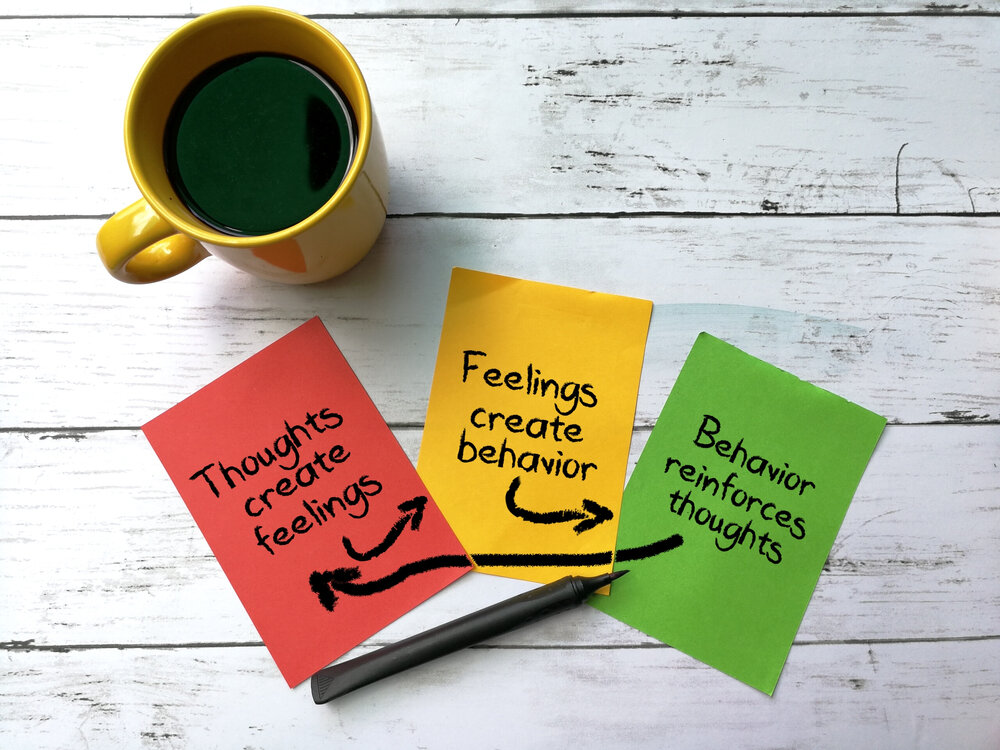How Does CBT Work?
With CBT, you can learn to break the cycle of unwanted thoughts, emotions, and behaviors. You can observe your automatic thoughts and thinking patterns, allowing you to step back and perceive them as “just thoughts.” You can learn to identify when they are “cognitive distortions” and develop rational responses to these distortions, enabling you to be in a better position to choose how to react to them.
With a more objective understanding and distance to your thoughts, you can design, in collaboration with your therapist, behavioral strategies consistent with your values, implemented at a pace comfortable for you. Most people achieve significant progress with CBT in a relatively short period of time.
What Does Cognitive Behavioral Therapy Treat?

For many people, persistent worry about things in life creates anxiety. It could be fear or stress over work, relationships, health, or finances. By helping you break down your patterns of thinking and behaviors, CBT is very effective at reducing anxiety. It’s no wonder CBT is backed by multiple studies for treating anxiety and many other conditions.
Cognitive behavioral therapy has been proven to be effective for people struggling with mild to moderate depression. CBT can help you uncover your core beliefs about yourself, the world, and the future. It can also foster healthy behavior changes to improve your mood, outlook, and self-esteem.
Social anxiety, also known as social phobia, is a particular type of anxiety disorder in which a person’s fear and distress is focused on the act of socializing with others. CBT can help reduce thoughts and feelings of social anxiety, leading to greater confidence in social interactions.
CBT can equip people with tools to manage panic attacks with less fear and distress. It can also help people who may have developed a phobia around a specific situation that is known to trigger panic attacks for them.
OCD is an anxiety disorder characterized by obsessive thoughts and compulsive behaviors. CBT, combined with exposure response prevention (ERP), is well suited to help disrupt the ruminations and compulsions often associated with OCD, resulting in healthier thoughts and behaviors.
People with phobias often go out of their way to avoid situations that trigger fear, distress, or discomfort. CBT can help people explore other ways of dealing with their fears and provide tools to help with their phobias.
Job stress is quite common, affecting approximately 83% of our workforce. In fact, the World Health Organization (WHO) formally recognized burnout as a diagnosable syndrome in 2019. Cognitive behavioral therapy, particularly CBT methods rooted in mindfulness, can help people who are struggling with job stress or other forms of burnout.
What Does Cognitive Behavioral Therapy Help With?
Cognitive behavioral therapy is well suited to help individuals dealing with a variety of struggles, including:
- Persistent worry: Occasional worry is a common experience, but chronic or persistent worry, whether over something specific or general, is often a cause for concern. CBT can help you understand the dynamics of your worry and redirect anxious thoughts in healthier directions.
- Fear of failure/perfectionism: Although failure can sting, it is a natural part of life. If you feel like failure is a catastrophe from which you cannot recover, or you feel pressure to be “perfect” in some way, shape, or form, then CBT can help you achieve your goals with less emotional distress.
- Indecision: When every choice, no matter how small, is treated as a high-stakes, all-important decision, it can lead to mental distress and decision-making paralysis. CBT can teach you how to break the cycle of indecision and start making choices with more confidence.
- Imposter syndrome: Imposter syndrome occurs when you feel like your success isn’t earned or that you’re a “fraud” in danger of being “found out.” Cognitive behavioral therapy can help neutralize the message of imposter syndrome and teach you how to balance confidence and humility.
What Is It Like Doing CBT?
Many people say doing CBT is different from traditional therapy in that it’s more practical, interactive, and structured, and yields better results. CBT sessions typically are:
- Collaborative/interactive: In CBT, you and your therapist work together as a team. You’ll collaborate to identify your aspirations, values, and goals for treatment. Together, you’ll discuss what changes you’d like to make, how best to achieve those changes, and the thoughts, feelings and behaviors involved.
- Present-day problem-solving: CBT typically focuses on tackling the problems you’re having in the present. While your therapist might help with understanding how the past relates to your present concerns at certain times and with certain conditions, CBT is designed to help you make desired changes and healthy improvements in your day-to-day life.
- Attention to thoughts: Our thoughts can have a powerful effect on our mood, our level of anxiety, and other emotions. CBT teaches you ways to identify unhealthy thought patterns, challenge those patterns, and develop healthier ways of thinking and reacting to life situations. CBT, along with ACT, can also help you gain a healthy distance from your thoughts, which puts you in a better position to implement healthy and productive behaviors.
- Acquiring skills: Gaining tangible skills is one of the most empowering aspects of doing CBT. Over time you can learn to 1) recognize cognitive distortions, 2) understand how to challenge or diffuse those thoughts, and 3) adopt healthier behaviors that align with your core values. You can use these skills to tackle your issues today, and long after therapy is over.


Feel Better with Cognitive Behavioral Therapy
Get started with a consultation for cognitive behavioral therapy at Behavioral Health of New York.
Find BHNY CBT Therapy Near You
Serving NYC, Westchester, and Long Island
Frequently Asked Questions
CBT is effective for the treatment of anxiety for most people. It’s one of the most widely used therapy methods for many types of anxiety such as generalized anxiety disorder (GAD), social anxiety, phobias, and panic attacks.
CBT can provide several strategies to improve ADHD, such as learning how to better manage one’s time or how to create a more structured environment.
CBT therapy is a relatively short-term treatment that often ranges between 10 and 20 sessions. It can be longer or shorter depending on the person’s needs. You and your therapist will determine how many sessions are best suited to you.
The goal of cognitive behavioral therapy is to teach people the skills to challenge or diffuse negative thoughts, the ability to respond to life events in healthier ways, and the tools to develop more productive behaviors—all which can lead to creating more positive life change.
CBT therapy is covered by insurance under mental health benefits which include coverage for “outpatient psychotherapy”. The coverage amount allowed for each session will depend on your particular benefit plan. Insurance can be very confusing. When you come to our practice, our office will determine your coverage and discuss your plan details with you before therapy sessions begin.


